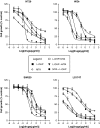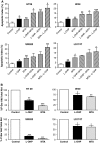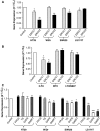Cellular and molecular mechanisms for the synergistic cytotoxicity elicited by oxaliplatin and pemetrexed in colon cancer cell lines
- PMID: 20020129
- PMCID: PMC2886085
- DOI: 10.1007/s00280-009-1195-2
Cellular and molecular mechanisms for the synergistic cytotoxicity elicited by oxaliplatin and pemetrexed in colon cancer cell lines
Abstract
Purpose: Oxaliplatin effect in the treatment of colorectal cancer is improved upon combination with thymidylate synthase (TS) inhibitors. Pemetrexed is polyglutamated by the folylpolyglutamate synthase (FPGS) and blocks folate metabolism and DNA synthesis by inhibiting TS, dihydrofolate reductase (DHFR) and glycinamide ribonucleotide formyltransferase (GARFT). The present study evaluates the pharmacological interaction between oxaliplatin and pemetrexed in colorectal cancer cells.
Methods: Human HT29, WiDr, SW620 and LS174T cells were treated with oxaliplatin and pemetrexed. Drug interaction was studied using the combination index method, while cell cycle was investigated with flow cytometry. The effects of drugs on Akt phosphorylation and apoptosis were studied with ELISA and fluorescence microscopy, respectively. RT-PCR analysis was performed to assess whether drugs modulated the expression of pemetrexed targets and of genes involved in DNA repair (ERCC1 and ERCC2). Finally, platinum-DNA adduct levels were detected by ultra-sensitive multi-collector inductively coupled plasma mass spectrometry (ICP-MS).
Results: A dose-dependent inhibition of cell growth was observed after drug exposure, while a synergistic interaction was detected preferentially with sequential combinations. Oxaliplatin enhanced cellular population in the S-phase. Drug combinations increased apoptotic indices with respect to single agents, and both drugs inhibited Akt phosphorylation. RT-PCR analysis showed a correlation between the FPGS/(TS x DHFR x GARFT) ratio and pemetrexed sensitivity, as well as a downregulation of ERCC1, ERCC2, TS, DHFR and GARFT after drug exposure. In addition, pretreatment with pemetrexed resulted in an increase of oxaliplatin-DNA adducts.
Conclusion: These data demonstrate that oxaliplatin and pemetrexed synergistically interact against colon cancer cells, through modulation of cell cycle, inhibition of Akt phosphorylation, induction of apoptosis and modulation of gene expression.
Figures




Similar articles
-
Molecular mechanisms underlying the synergistic interaction of erlotinib, an epidermal growth factor receptor tyrosine kinase inhibitor, with the multitargeted antifolate pemetrexed in non-small-cell lung cancer cells.Mol Pharmacol. 2008 Apr;73(4):1290-300. doi: 10.1124/mol.107.042382. Epub 2008 Jan 10. Mol Pharmacol. 2008. PMID: 18187583
-
Effects of pemetrexed, gefitinib, and their combination on human colorectal cancer cells.Cancer Chemother Pharmacol. 2013 Oct;72(4):767-75. doi: 10.1007/s00280-013-2251-5. Cancer Chemother Pharmacol. 2013. PMID: 23959460
-
Cellular and pharmacogenetics foundation of synergistic interaction of pemetrexed and gemcitabine in human non-small-cell lung cancer cells.Mol Pharmacol. 2005 Jul;68(1):110-8. doi: 10.1124/mol.104.009373. Epub 2005 Mar 28. Mol Pharmacol. 2005. PMID: 15795320
-
Pemetrexed combination therapy in the treatment of non-small cell lung cancer.Semin Oncol. 2002 Apr;29(2 Suppl 5):23-9. doi: 10.1053/sonc.2002.30768. Semin Oncol. 2002. PMID: 12023789 Review.
-
Overview of phase I/II pemetrexed studies.Oncology (Williston Park). 2004 Nov;18(13 Suppl 8):18-25. Oncology (Williston Park). 2004. PMID: 15655932 Review.
Cited by
-
Building a Bridge between Chemotherapy and Immunotherapy in Malignant Pleural Mesothelioma: Investigating the Effect of Chemotherapy on Immune Checkpoint Expression.Int J Mol Sci. 2019 Aug 26;20(17):4182. doi: 10.3390/ijms20174182. Int J Mol Sci. 2019. PMID: 31455014 Free PMC article.
-
Heterogeneity in cancer cells: variation in drug response in different primary and secondary colorectal cancer cell lines in vitro.In Vitro Cell Dev Biol Anim. 2017 May;53(5):435-447. doi: 10.1007/s11626-016-0126-x. Epub 2017 Jan 24. In Vitro Cell Dev Biol Anim. 2017. PMID: 28120247
-
Evaluation of the Anticancer Potential of Morus nigra and Ocimum basilicum Mixture against Different Cancer Cell Lines: An In Vitro Evaluation.Biomed Res Int. 2023 Apr 19;2023:9337763. doi: 10.1155/2023/9337763. eCollection 2023. Biomed Res Int. 2023. Retraction in: Biomed Res Int. 2024 Jan 9;2024:9847989. doi: 10.1155/2024/9847989. PMID: 37124934 Free PMC article. Retracted.
-
Preclinical emergence of vandetanib as a potent antitumour agent in mesothelioma: molecular mechanisms underlying its synergistic interaction with pemetrexed and carboplatin.Br J Cancer. 2011 Nov 8;105(10):1542-53. doi: 10.1038/bjc.2011.400. Epub 2011 Oct 4. Br J Cancer. 2011. PMID: 21970874 Free PMC article.
-
Role of Bcl-xL/Beclin-1 in interplay between apoptosis and autophagy in oxaliplatin and bortezomib-induced cell death.Biochem Pharmacol. 2014 Mar 15;88(2):178-88. doi: 10.1016/j.bcp.2014.01.027. Epub 2014 Jan 31. Biochem Pharmacol. 2014. PMID: 24486574 Free PMC article.
References
-
- Raymond E, Faivre S, Chaney S, Woynarowski J, Cvitkovic E. Cellular and molecular pharmacology of oxaliplatin. Mol Cancer Ther. 2002;1:227–235. - PubMed
Publication types
MeSH terms
Substances
Grants and funding
LinkOut - more resources
Full Text Sources
Research Materials

